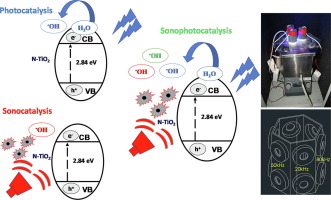Chemical Engineering Journal ( IF 13.3 ) Pub Date : 2020-03-21 , DOI: 10.1016/j.cej.2020.124853 Ansaf V. Karim , Amritanshu Shriwastav

|
This study investigates the degradation of an antibiotic Ciprofloxacin (CPX) by the photocatalytic, sonocatalytic and sonophotocatalytic oxidation inside a novel multi-frequency reactor under low ultrasonic frequencies and visible light using N-doped TiO2 (N-TiO2) nanoparticles as the catalysts. The synthesized nanoparticles were characterized by XRD, FTIR, TEM, BET and UV-Vis reflectance spectroscopy. The average particle size of these nanoparticles was in the range of 12-18 nm. The effects of different operational parameters affecting the CPX degradation during these processes were studied. Maximum CPX degradation of 54.5%, 41.2%, and 44 % was observed for photocatalysis, sonocatalysis and sonophotocatalysis under their individual optimum conditions after 210, 90, and 90 minutes respectively. The application of these doped catalysts improved the photocatalytic and sonocatalytic oxidation of CPX due to the improved visible light activity and extra nuclei for cavitation respectively. Further, a synergistic effect was observed by the simultaneous application of light and ultrasound in sonophotocatalytic oxidation in comparison to individual processes with a synergy index of 1.22. During the Sonophotocatalysis process, the simultaneous application of ultrasound and visible light was found more effective in comparison to their sequential or intermittent application. The degradation products in all three oxidation processes were identified, and potential degradation pathways are proposed. In addition, effect of real wastewater matrix on the process performance was also investigated.
中文翻译:

使用可见光和低频超声的光,声和声光催化氧化降解环丙沙星:降解动力学和途径
这项研究研究了在低超声频率和可见光下使用N掺杂的TiO 2(N-TiO 2)在新型多频反应器中通过光催化,声催化和声光催化氧化降解抗生素环丙沙星(CPX)的过程。)纳米粒子作为催化剂。通过XRD,FTIR,TEM,BET和UV-Vis反射光谱对合成的纳米颗粒进行表征。这些纳米颗粒的平均粒径在12-18nm的范围内。研究了在这些过程中不同操作参数对CPX降解的影响。分别在210、90和90分钟后,分别在各自的最佳条件下,光催化,声催化和声光催化的最大CPX降解分别为54.5%,41.2%和44%。这些掺杂催化剂的应用分别由于改善的可见光活性和用于汽蚀的额外核而改善了CPX的光催化和声催化氧化。进一步,与具有1.22协同指数的单个过程相比,通过在声光催化氧化中同时应用光和超声观察到了协同效应。在声光催化过程中,与连续或间歇使用超声波和可见光相比,同时使用超声波和可见光更为有效。确定了所有三个氧化过程中的降解产物,并提出了潜在的降解途径。此外,还研究了真实废水基质对工艺性能的影响。确定了所有三个氧化过程中的降解产物,并提出了潜在的降解途径。此外,还研究了真实废水基质对工艺性能的影响。确定了所有三个氧化过程中的降解产物,并提出了潜在的降解途径。此外,还研究了真实废水基质对工艺性能的影响。











































 京公网安备 11010802027423号
京公网安备 11010802027423号